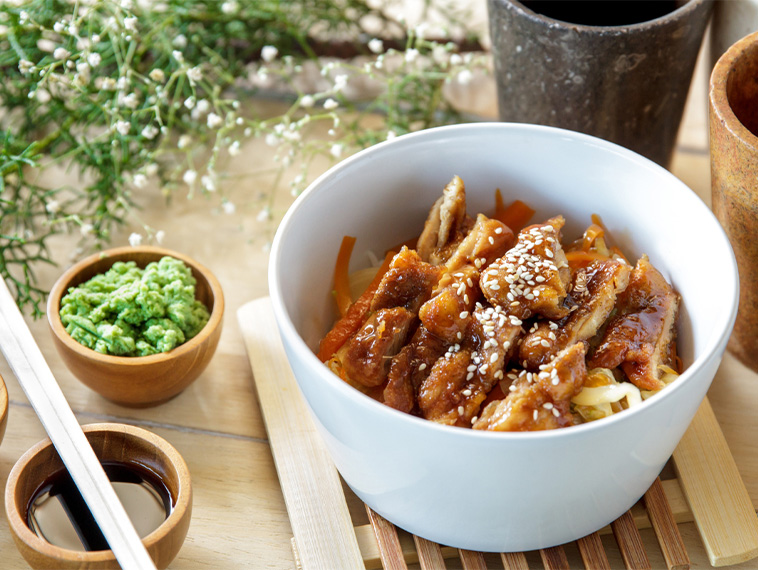Dark soy sauce is often overshadowed by its lighter counterpart and deserves its moment in the spotlight. This isn't just any soy sauce; it's a rich, complex, and versatile ingredient with a history as deep as its color. As a staple in many Asian cuisines, dark soy sauce adds more than just taste; it brings depth, color, and character to dishes. Whether it's used to marinate meats, enhance stir-fries, or as a base in sauces, its presence is unmistakable.
In this post, I will explain this rich dark soy sauce, how it is different from light soy sauce, and how to use it.
What is Dark Soy Sauce
Dark soy sauce is an often underappreciated yet integral component of many Asian cuisines and presents a fascinating journey from its traditional origins to the modern kitchen. This variant of soy sauce distinguishes itself with a characteristically darker color, a thicker consistency, and a flavor profile that is less salty but more intense than its lighter counterpart.
Originating from ancient Chinese culinary practices, dark soy sauce is the product of a prolonged fermentation process of soybeans, wheat, and a fermenting agent like mold or yeast. Unlike regular soy sauce, which is made from pressing fermented soybeans, the extended fermentation deepens the color and enhances the sauce's umami and slightly sweet undertones. This also makes it not a gluten-free soy sauce.
In culinary applications, dark soy sauce is not merely a seasoning but a transformative ingredient. It imparts a rich, caramel-like color to dishes such as stir-fries, stews, and marinades, playing a crucial role in the cuisine's flavor and visual appeal. Its versatility extends beyond traditional Asian dishes, blending into contemporary fusion and experimental cooking. Avoid using regular dark soy sauce unless the recipe calls for it, as it is strong and can overpower the dish.

What is the difference between light and dark soy sauce?
Dark soy sauce and light soy sauce, while both staples in Asian cuisine, have distinct differences that set them apart. One of the primary differences lies in their fermentation process and aging; dark soy sauce undergoes a longer fermentation period than its lighter counterpart. This results in a richer flavor and darker color for dark soy sauce. When it comes to taste, light soy sauce tends to be saltier. It has a more pronounced soybean taste, making it ideal for seasoning and adding flavor without significantly altering the color of a dish. Dark soy sauce, however, is less salty but possesses a more intense and slightly sweet flavor due to the addition of molasses or similar sweetening agents during its production.
The consistency also varies; dark soy sauce is thicker and more viscous, a trait attributed to its extended fermentation and the possible inclusion of caramel or molasses. This contrasts with the lighter and more fluid consistency of light soy sauce. The color difference is quite apparent, with dark soy sauce imparting a rich, dark tint to dishes while light soy sauce maintains the dish's original color.
In the culinary world, these sauces have specific uses. Light soy sauce is commonly used in marinades, dipping sauces, and general seasoning, enhancing the dish without changing its color. Dark soy sauce, conversely, is favored in dishes where color and a mild sweetness are desired, such as in stews, braises, and stir-fries. Furthermore, it's important to note that regional variations exist within these soy sauces across different Asian cuisines, each varying in flavor, consistency, and sweetness. Replacing one with the other in recipes can substantially modify the taste and appearance of a dish, underscoring the significance of comprehending their distinct characteristics.
What is the difference between dark soy sauce and regular soy sauce?
The key difference between dark soy sauces and regular (or light) soy sauces is their flavor, consistency, color, and culinary uses. Dark soy sauce, known for its thicker consistency and deeper color, undergoes a longer fermentation process than regular soy sauce. This extended aging results in a less salty, richer, and subtly sweet flavor, often due to the addition of molasses or a similar sweetening agent. Dark soy sauce is primarily used to add color and a mild sweetness to dishes, making it a popular choice in stews, braises, and certain stir-fries where a rich, caramel-like hue is desired.
Regular soy sauce, often called light soy sauce, has a thinner consistency and lighter color. It has a more pronounced saltiness and a distinct soybean flavor, making it versatile for various culinary applications. Regular soy sauce is commonly used for seasoning, in marinades, and as a dipping sauce, as it enhances the flavor of a dish without significantly altering its color.
The choice between dark and regular soy sauce can greatly influence a dish's taste, appearance, and overall character, making it essential to use them according to their specific culinary roles.
Is Dark Soy Sauce Gluten-free
Traditionally, dark soy sauce is made using a blend of fermented soybeans and wheat, which typically contains gluten. Fortunately, for individuals who are gluten-intolerant or have celiac disease, there is positive news. The culinary world has evolved, and many brands now offer gluten-free versions of dark soy sauce. These are crafted using alternative grains or methods that eliminate gluten while still retaining the rich, savory flavor and dark, inviting color that dark soy sauce is known for. So, while not all dark soy sauces are gluten-free, there are certainly options available for those seeking the depth and character of this sauce without the gluten.

Dark Soy Sauce Varieties
Chinese Dark Soy Sauce
A staple in Chinese cooking, this variety is known for its rich, almost syrup-like consistency and deep, dark color. It's aged longer than light soy sauce, producing a less salty, somewhat sweet flavor. Chinese dark soy sauce is often used to add a beautiful caramel color and a mild sweetness to dishes like Shanghai rice cake, red-braised pork and beef stews and as a crucial ingredient in sauces and marinades. It's also a key component in achieving the classic color of many noodle and rice dishes.
Japanese Dark Soy Sauce (Koikuchi Shoyu)
This variety of soy sauce is the most common in Japanese cuisine and is, in fact, regarded as their "regular" soy sauce. It has a slightly fuller, richer flavor than light soy sauce but is not as thick or sweet as Chinese soy sauce. Koikuchi Shoyu is a primary type of Japanese soy sauce, and it is used in a wide array of Japanese dishes, from sushi and sashimi to marinades and broths, providing a balanced umami flavor.
Indonesian Dark Soy Sauce (Kecap Manis)
Remarkably distinct, Kecap Manis is a very thick, sweet soy sauce enriched with palm sugar and an assortment of aromatic spices like garlic, star anise, and sometimes ginger. It has a molasses-like consistency and is essential in many Indonesian dishes such as Nasi Goreng (fried rice) and satays and as a dipping sauce. Its sweet and savory flavor is essential to the distinctive taste of Indonesian cuisine.
Malaysian Dark Soy Sauce
This variety, often found in Malaysian cooking, is similar to Kecap Manis but generally less sweet. It imparts a rich, caramelized flavor and dark color to popular dishes like Char Kway Teow (stir-fried noodles) and Hainanese Chicken Rice. This soy sauce adds depth and a slight sweetness to Malaysian dishes, enhancing their overall flavor profile.
Thai Dark Soy Sauce (Sì-io dam)
In Thai cuisine, this type of dark soy sauce is used primarily for its color and a touch of sweetness. It's less sweet than the Indonesian Kecap Manis and has a consistency that's not too thick. Thai dark soy sauce is a crucial ingredient in many stir-fries and noodle dishes like Pad See Ew and adds a beautiful color to Thai marinated meats and sauces.
Taiwanese Dark Soy Sauce
Taiwanese dark soy sauce shares similarities with the Chinese version but may vary in sweetness and viscosity. It's used in Taiwanese cooking to enhance the flavor and color of dishes like Lu Rou Fan (braised pork rice) and beef noodle soup. The unique blend of sweetness and umami in Taiwanese dark soy sauce reflects the local taste preferences and culinary traditions.
How To Use Dark Soy Sauce
Color with Confidence
When it comes to adding a visually appealing touch to your dishes, dark soy sauce is a game-changer. Its rich, deep color elevates the visual appeal of various dishes, especially in Asian cuisine. Use it in stir-fries, fried rice, and noodle dishes to achieve that classic, appetizing color. Just a few teaspoons can transform a pale dish into something that looks as mouth watering as it tastes.
Marinate Magic
Elevate your marinating game with dark soy sauce. Its intense flavor profile, which is less salty but richer than light soy sauce, makes it an ideal base for marinades. It infuses meat like chicken, beef, or pork with a complex, savory depth. Combine it with ingredients like garlic, ginger, and honey to create a marinade that tenderizes the meat and adds a robust flavor, perfect for grilling or roasting.
Stews and Braises
Incorporate dark soy sauce into your stews and braises to enrich the dish's flavor palette. Its slightly sweet undertones and rich texture add a new dimension to slow-cooked meals. A tablespoon or two in your beef stew or braised pork belly can deepen the flavors, making each bite a harmonious blend of savory and sweet. It proves particularly effective in dishes demanding extended cooking times, enabling the flavors to blend and intensify.
Glazing Glory
Dark soy sauce can be your secret ingredient for creating a beautiful glaze on grilled or roasted meats and vegetables. When brushed on towards the end of cooking, it caramelizes perfectly, providing a glossy finish and a layer of flavor. This caramelization adds a subtle sweetness and an attractive sheen, making your dishes delicious and visually stunning.
Fusion and Innovation
Dark soy sauce's versatility extends beyond traditional Asian cuisine. Experiment with it in nontraditional ways, such as adding it to barbecue sauces, salad dressings, or even marinades for Western-style grilling. Its unique taste can bring a surprising twist to familiar dishes, offering a fusion of flavors that can inspire new culinary creations.
